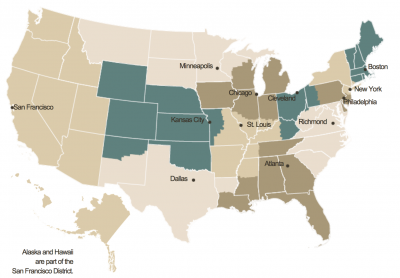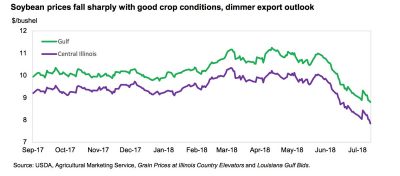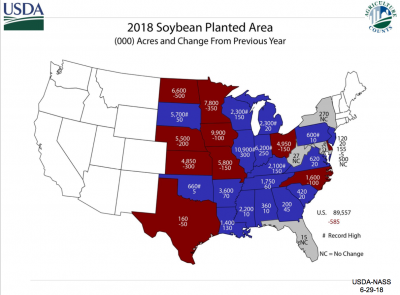Beef prices are projected to continue increasing as U.S. beef production declines with no signs of a cattle herd rebuild. Additionally, cheap beef may soon become further out of reach…
Federal Reserve: Observations on the Ag Economy- July 2018
On Wednesday, the Federal Reserve Board released its July 2018 Beige Book update, a summary of commentary on current economic conditions by Federal Reserve District. The report included several observations pertaining to the U.S. agricultural economy.

* Sixth District- Atlanta– “Agriculture conditions across the District were mixed. Significant rain improved drought conditions in Alabama, Florida, and Georgia; however, there were abnormally dry conditions reported mostly in Louisiana and to a lesser degree in Mississippi and Tennessee. There were also some areas that experienced above-normal temperatures and locally heavy rains, resulting in some crop stress.
Topsoil Moisture, Percent Short to Very Short- Week Ending July 15, Weekly Weather and Crop Bulletin, https://t.co/ndnIKzot5o @USDA pic.twitter.com/S9apcPukFs
— Farm Policy (@FarmPolicy) July 17, 2018
“June’s forecast for Florida’s orange crop was unchanged from May, but down significantly from last season’s production. On a year-over-year basis, prices paid to farmers in April were up for corn, rice, soybeans, broilers, and eggs and down for cotton and beef.”
* Seventh District- Chicago– “The outlook for agriculture income dimmed some over the reporting period as prices for most commodities fell. Crop farmers reported that in general, field conditions were excellent and better than last year.
#Illinois #corn condition now 80% good to excellent, down 4 points from last week. #agchat @ILAgriculture @usda_nass. Full report at: https://t.co/oCdxePcMtU pic.twitter.com/aJkEyG4700
— Farm Policy (@FarmPolicy) July 16, 2018
“Both corn and soybean prices fell, reducing expected profits from the upcoming harvest.

Livestock farmers continued to struggle overall, with some reports of asset sales by hog producers and closures of dairy operations.
Contacts throughout the District expressed heightened concerns about the impact of trade disputes and tariffs on the agricultural industry.
* Eighth District- St. Louis– “Agriculture conditions weakened slightly from the previous reporting period, but improved slightly from the same time last year. The percentages of corn, cotton, and rice rated fair or better in June declined slightly relative to the prior month, while that of soybeans increased modestly. However, both the corn and soybeans percentages were higher than a year ago, the cotton percentage was little changed, and the rice percentage was down slightly.
Estimated soybean acreage saw a substantial upward adjustment in Illinois relative to March planting intentions but was revised downward in Missouri.

* Ninth District- Minneapolis– “District agricultural conditions were stable relative to the previous report. Despite a late start to the planting season, crop progress in District states as of late June was generally in line with five-year averages, and the majority of crops were rated in good or excellent condition. However, some areas of the Dakotas and Montana were experiencing dry or moderate drought conditions.”
* Tenth District- Kansas City– “The Tenth District farm economy weakened slightly, and drought persisted in some regions.
Trade uncertainty and expectations of larger supplies in 2018 put downward pressure on crop prices.
“Corn prices were slightly lower than a year ago following a sharp decline in June, while soybean prices declined even more rapidly and reached an eight-year low. Although prices for wheat remained steady and slightly higher than a year ago, revenues in Kansas and Oklahoma could remain strained as nearly half of winter wheat acreage was rated as poor or very poor due to dry conditions. Livestock prices were slightly lower than one year ago following modest declines in June. Hog prices, which continued to be supported by expectations of increased U.S. exports and relatively strong global demand, increased slightly in June but remained slightly below levels from one year ago.”
#Mexico #pork #tariffs: From what little data is publicly available, it appears that volumes of US product continued to flow to Mexico, w/ a recovery in shipments after dipping almost 26% in the third week of June (the week ending June 21, 2018) https://t.co/yKxHL0sEnc @USDA_ERS pic.twitter.com/duy4bYYTgr
— Farm Policy (@FarmPolicy) July 18, 2018
* Eleventh District- Dallas– “Drought conditions became slightly less severe but more widespread over the reporting period.
Texas farmers were concerned because the drought will likely suppress crop yields, and crop prices are lower due to trade restrictions and strong U.S. production prospects.
“Grazing conditions remained well below average, and cattle prices experienced a slightly higher-than-average seasonal decline over the last six weeks, despite strong export and domestic demand for beef.”
* Twelfth District- San Francisco– “Conditions in the agriculture sector deteriorated modestly. In California, yields for various crops fell because of weak precipitation levels in recent months. In the Mountain West, feedlot profits fell noticeably on a year-over-year basis, and profits at dairy and pork producers declined moderately. A pickup in global demand for raisins and nuts resulted in a slight increase in exports of these crops. Potato yields in Idaho were solid, and inventory levels improved from the same period last year.”





